名词用法归纳
英语中名词的位置归纳总结
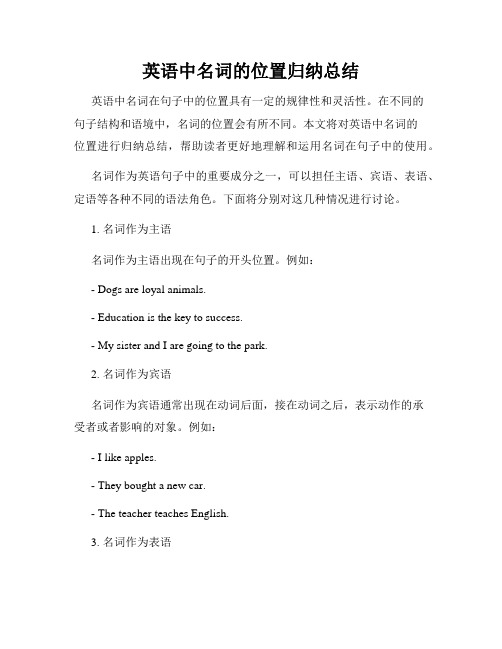
英语中名词的位置归纳总结英语中名词在句子中的位置具有一定的规律性和灵活性。
在不同的句子结构和语境中,名词的位置会有所不同。
本文将对英语中名词的位置进行归纳总结,帮助读者更好地理解和运用名词在句子中的使用。
名词作为英语句子中的重要成分之一,可以担任主语、宾语、表语、定语等各种不同的语法角色。
下面将分别对这几种情况进行讨论。
1. 名词作为主语名词作为主语出现在句子的开头位置。
例如:- Dogs are loyal animals.- Education is the key to success.- My sister and I are going to the park.2. 名词作为宾语名词作为宾语通常出现在动词后面,接在动词之后,表示动作的承受者或者影响的对象。
例如:- I like apples.- They bought a new car.- The teacher teaches English.3. 名词作为表语名词作为表语一般出现在系动词(be动词)之后,用于描述主语的性质、状态或身份等。
例如:- She is a doctor.- The movie was a success.- The weather today is sunny.4. 名词作为定语名词作为定语修饰其他名词时,出现在被修饰名词的前面,用于具体描述被修饰名词的特点、属性或类别等。
例如:- School bus- Coffee shop- Sports car5. 名词作为补语名词作为补语通常出现在及物动词或感官动词(如see, watch, hear 等)后面,用来补充说明主语的状态或感受等。
例如:- I found her asleep.- He felt the water cold.- We saw them happy.6. 名词在从句中的位置在从句中,名词的位置根据从句的语法结构来确定。
例如,在名词性从句中,名词可以作为主语、宾语或表语出现。
名词的用法归纳
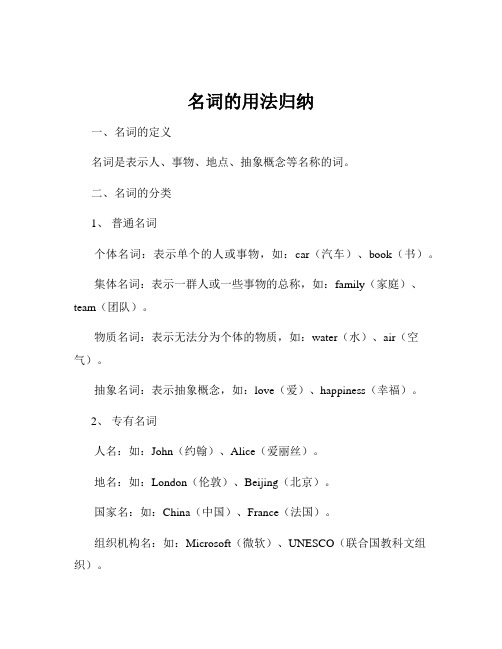
名词的用法归纳一、名词的定义名词是表示人、事物、地点、抽象概念等名称的词。
二、名词的分类1、普通名词个体名词:表示单个的人或事物,如:car(汽车)、book(书)。
集体名词:表示一群人或一些事物的总称,如:family(家庭)、team(团队)。
物质名词:表示无法分为个体的物质,如:water(水)、air(空气)。
抽象名词:表示抽象概念,如:love(爱)、happiness(幸福)。
2、专有名词人名:如:John(约翰)、Alice(爱丽丝)。
地名:如:London(伦敦)、Beijing(北京)。
国家名:如:China(中国)、France(法国)。
组织机构名:如:Microsoft(微软)、UNESCO(联合国教科文组织)。
三、名词的数1、可数名词规则复数形式11 一般在词尾加 s,如:desk desks(书桌)、book books(书)。
12 以 s、x、ch、sh 结尾的名词,加 es,如:box boxes(盒子)、watch watches(手表)。
13 以辅音字母+ y 结尾的名词,变 y 为 i 再加 es,如:city cities (城市)、baby babies(婴儿)。
14 以 o 结尾的名词,有生命的加 es,无生命的加 s,如:tomato tomatoes(西红柿)、photo photos(照片)。
15 以 f 或 fe 结尾的名词,变 f 或 fe 为 v 再加 es,如:leaf leaves(叶子)、knife knives(刀)。
不规则复数形式16 man men(男人)、woman women(女人)、child children(孩子)、foot feet(脚)、tooth teeth(牙齿)、mouse mice(老鼠)等。
单复数同形17 sheep(绵羊)、deer(鹿)、fish(鱼,指条数时)、Chinese(中国人)、Japanese(日本人)等。
英语名词与冠词的用法归纳

英语名词与冠词的用法归纳一、名词的基本用法名词是指用来表示人、事、物、地点等具体或抽象概念的词语。
在英语语法中,名词有一些基本的用法,包括单数形式、复数形式、所有格等。
1. 单数形式名词的单数形式用来表示一个人、事物或概念。
例如:cat(猫)、book(书)、idea(想法)等。
2. 复数形式名词的复数形式用来表示多个人、事物或概念。
通常在名词的末尾加上's'或'es'来表示复数。
例如:cats(猫们)、books(书们)、ideas (想法们)等。
3. 所有格名词的所有格形式用来表示所属关系或归属关系。
通常在名词的末尾加上"'s"或"'"来表示所有格。
例如:John's book(约翰的书)、the dog's tail(狗的尾巴)等。
二、冠词的用法冠词是用来限定名词的词语,包括不定冠词"a"和"an",以及定冠词"the"。
1. 不定冠词"a"和"an"不定冠词"a"和"an"用来表示泛指或不确定的人、事物或概念。
通常用"a"来修饰以辅音音素开头的单数名词,用"an"来修饰以元音音素开头的单数名词。
例如:a cat(一只猫)、an apple(一个苹果)等。
2. 定冠词"the"定冠词"the"用来表示特指或已知的人、事物或概念。
它可以修饰单数名词、复数名词以及不可数名词。
例如:the cat(那只猫)、the books(那些书)等。
三、名词与冠词的特殊用法除了基本的名词和冠词用法之外,还有一些特殊的用法需要注意。
1. 特指某个领域或行业的名词在某些特定的领域或行业中,名词前面会使用定冠词"the"来表示该领域或行业的特定事物。
英语名词的用法归纳
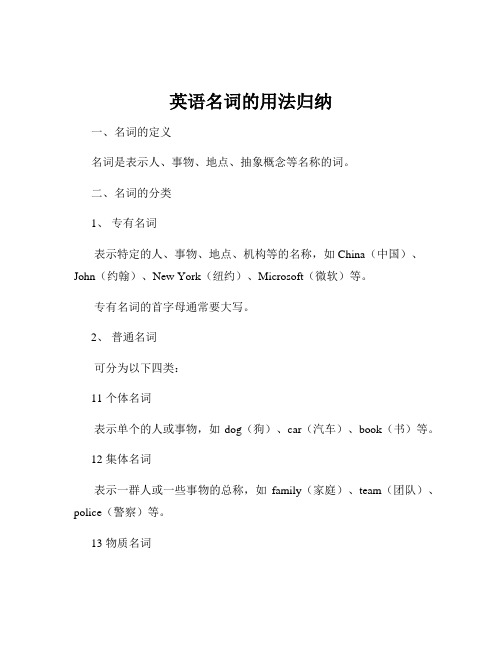
英语名词的用法归纳一、名词的定义名词是表示人、事物、地点、抽象概念等名称的词。
二、名词的分类1、专有名词表示特定的人、事物、地点、机构等的名称,如 China(中国)、John(约翰)、New York(纽约)、Microsoft(微软)等。
专有名词的首字母通常要大写。
2、普通名词可分为以下四类:11 个体名词表示单个的人或事物,如 dog(狗)、car(汽车)、book(书)等。
12 集体名词表示一群人或一些事物的总称,如family(家庭)、team(团队)、police(警察)等。
13 物质名词表示无法分为个体的物质或材料,如 water(水)、air(空气)、wood(木材)等。
14 抽象名词表示抽象的概念、性质、状态、情感等,如 love(爱)、happiness (幸福)、knowledge(知识)等。
三、名词的数1、可数名词有单数和复数形式。
单数名词表示一个,复数名词表示两个或两个以上。
复数形式的构成规则:11 一般在词尾加 s,如 book books,dog dogs。
12 以 s,x,ch,sh 结尾的名词,加 es,如 bus buses,box boxes,watch watches,dish dishes。
13 以“辅音字母+y”结尾的名词,变 y 为 i 再加 es,如 city cities,baby babies。
14 以 o 结尾的名词,有生命的加 es,无生命的加 s,如 tomato tomatoes,photo photos。
15 以 f 或 fe 结尾的名词,变 f 或 fe 为 v 再加 es,如 knife knives,leaf leaves。
不规则复数形式,如 man men,woman women,child children,foot feet,tooth teeth 等。
2、不可数名词没有复数形式。
表示物质或抽象概念的不可数名词,在表示数量时,要用“数词+表示量的名词+ of +不可数名词”的结构,如 a piece of paper(一张纸),a cup of coffee(一杯咖啡)。
初中英语知识点归纳名词的分类及用法
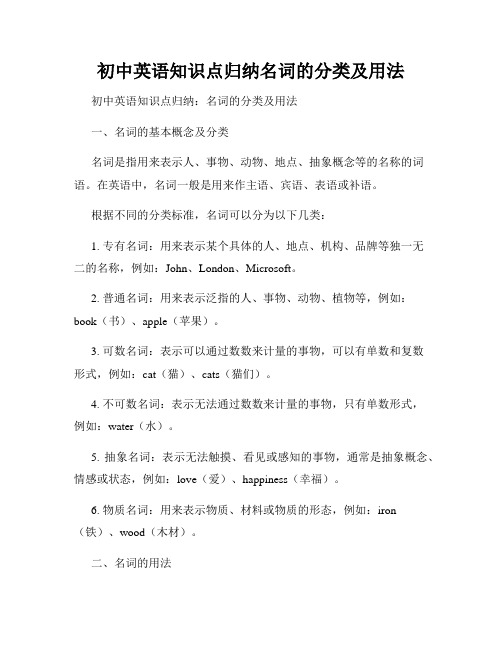
初中英语知识点归纳名词的分类及用法初中英语知识点归纳:名词的分类及用法一、名词的基本概念及分类名词是指用来表示人、事物、动物、地点、抽象概念等的名称的词语。
在英语中,名词一般是用来作主语、宾语、表语或补语。
根据不同的分类标准,名词可以分为以下几类:1. 专有名词:用来表示某个具体的人、地点、机构、品牌等独一无二的名称,例如:John、London、Microsoft。
2. 普通名词:用来表示泛指的人、事物、动物、植物等,例如:book(书)、apple(苹果)。
3. 可数名词:表示可以通过数数来计量的事物,可以有单数和复数形式,例如:cat(猫)、cats(猫们)。
4. 不可数名词:表示无法通过数数来计量的事物,只有单数形式,例如:water(水)。
5. 抽象名词:表示无法触摸、看见或感知的事物,通常是抽象概念、情感或状态,例如:love(爱)、happiness(幸福)。
6. 物质名词:用来表示物质、材料或物质的形态,例如:iron (铁)、wood(木材)。
二、名词的用法1. 名词作为主语:名词可以在句子中作为主语,用来说明句子所要表达的主要内容,例如:- Dogs are friendly animals.(狗是友好的动物。
)- Learning English is important for students.(学习英语对学生来说很重要。
)2. 名词作为宾语:名词可以在句子中作为宾语,接受动作的行为,例如:- I bought a new book.(我买了一本新书。
)- She loves playing soccer.(她喜欢踢足球。
)3. 名词作为表语:名词可以在句子中作为表语,用来补充说明主语的身份、性质或状态,例如:- The winner is him.(胜利者是他。
)- My hobby is swimming.(我的爱好是游泳。
)4. 名词作为补语:名词可以在句子中作为补语,用来补充说明句子的主语或宾语的属性,例如:- I am a teacher.(我是一名老师。
英语名词笔记总结归纳
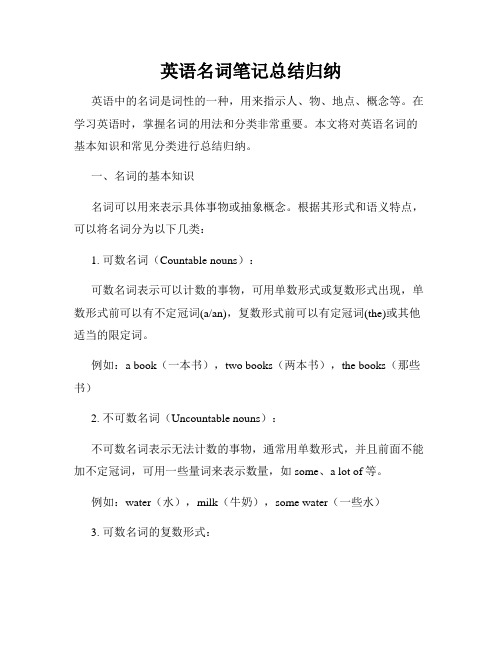
英语名词笔记总结归纳英语中的名词是词性的一种,用来指示人、物、地点、概念等。
在学习英语时,掌握名词的用法和分类非常重要。
本文将对英语名词的基本知识和常见分类进行总结归纳。
一、名词的基本知识名词可以用来表示具体事物或抽象概念。
根据其形式和语义特点,可以将名词分为以下几类:1. 可数名词(Countable nouns):可数名词表示可以计数的事物,可用单数形式或复数形式出现,单数形式前可以有不定冠词(a/an),复数形式前可以有定冠词(the)或其他适当的限定词。
例如:a book(一本书),two books(两本书),the books(那些书)2. 不可数名词(Uncountable nouns):不可数名词表示无法计数的事物,通常用单数形式,并且前面不能加不定冠词,可用一些量词来表示数量,如some、a lot of等。
例如:water(水),milk(牛奶),some water(一些水)3. 可数名词的复数形式:可数名词的复数形式通常通过在单数形式后面加上 -s 或 -es 来表示,但也有一些特殊的变化规则需要掌握。
例如:cat(单数),cats(复数);box(单数),boxes(复数)4. 不可数名词的量词:不可数名词表示不可分割或无法具体计数的事物,因此不能用复数形式,而是使用一些量词来表示数量。
例如:a cup of coffee(一杯咖啡),two bottles of milk(两瓶牛奶)5. 特殊名词:英语中还有一些名词是特殊的,它们的复数形式和意义与单数形式不同,需要特别注意。
例如:child(单数),children(复数);tooth(单数),teeth(复数)二、名词的分类除了可数名词和不可数名词的区分外,名词还可以根据其所属的类别进行分类。
以下是常见的名词分类:1. 个体名词(Individual nouns):个体名词用来指代独立的个体,可以是人、动物或具体的物体等。
名词解释词性归纳总结

名词解释词性归纳总结名词是一类用来表示人、事物、地点和抽象概念的词汇。
根据其用法和功能,名词可以分为多个不同的词性。
本文将对名词的各种词性进行解释和总结,以帮助读者更好地理解和运用名词。
1. 名词作主语名词作为句子的主语时,通常表示一个人、一个事物或一个概念。
例如:- Dogs are loyal animals.(狗是忠诚的动物。
)- Education is the key to success.(教育是成功的关键。
)2. 名词作宾语名词作为句子的宾语时,接受动作的对象或受到影响的人或物。
例如:- I love cats.(我喜欢猫。
)- She bought a new car.(她买了一辆新车。
)3. 名词作定语名词作为定语时,用来修饰其他名词或代词,说明其属性或类别。
例如:- The city park is beautiful.(城市公园很美丽。
)- A history book tells us about the past.(一本历史书告诉我们过去的事情。
)4. 名词作宾补名词可以作为某些动词的宾补,起到补充说明的作用。
例如:- They elected him president.(他们选举他当总统。
)- We consider honesty an important virtue.(我们认为诚实是一种重要的品德。
)5. 名词作介词宾语名词可以作为介词的宾语,表示介词所指的对象。
例如:- He is afraid of snakes.(他害怕蛇。
)- She went to the beach with her friends.(她和朋友们一起去了海滩。
)6. 名词作表语名词可以作为表语,用来说明主语的身份、特征或状态。
例如:- My job is a teacher.(我的工作是一名教师。
)- The winner is John.(获胜者是约翰。
)7. 名词作补语名词可以作为某些系动词的补语,用来补充说明主语的身份或状态。
英语名词用法归纳
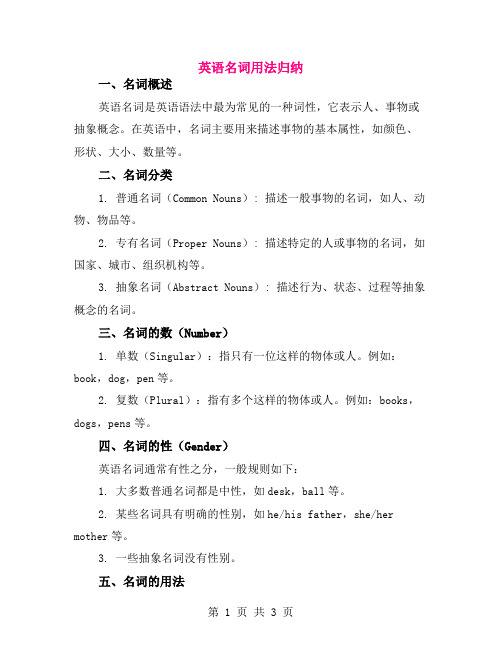
英语名词用法归纳一、名词概述英语名词是英语语法中最为常见的一种词性,它表示人、事物或抽象概念。
在英语中,名词主要用来描述事物的基本属性,如颜色、形状、大小、数量等。
二、名词分类1. 普通名词(Common Nouns): 描述一般事物的名词,如人、动物、物品等。
2. 专有名词(Proper Nouns): 描述特定的人或事物的名词,如国家、城市、组织机构等。
3. 抽象名词(Abstract Nouns): 描述行为、状态、过程等抽象概念的名词。
三、名词的数(Number)1. 单数(Singular):指只有一位这样的物体或人。
例如:book,dog,pen等。
2. 复数(Plural):指有多个这样的物体或人。
例如:books,dogs,pens等。
四、名词的性(Gender)英语名词通常有性之分,一般规则如下:1. 大多数普通名词都是中性,如desk,ball等。
2. 某些名词具有明确的性别,如he/his father,she/her mother等。
3. 一些抽象名词没有性别。
五、名词的用法1. 修饰名词的常见限定词包括形容词和限定词,如“a red book”,这里的“red”是形容词,“a”是限定词。
2. 代词可以用来代替名词,如“this is my book”,这里的“my book”可以被“it”代替。
3. 数词常用于表示数量或顺序,如“one book”,“first book”。
4. 同位语通常用来解释一个名词的具体内容,如“my sister, a teacher of English”,这里的“English”就是同位语。
5. 动词的第三人称形式常常与复数形式的名词连用,表示正在进行的动作或存在的状态,如“he reads a book every day”。
6. 复合名词(Compound Nouns)是由两个或更多的词组成的,它们通常通过连词符号“-”连接起来,如“playground”,“sandwich”等。
名词的用法归纳总结
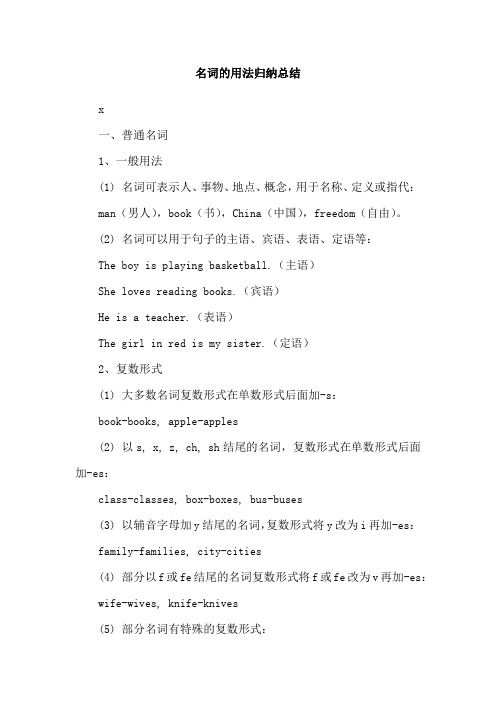
名词的用法归纳总结x一、普通名词1、一般用法(1) 名词可表示人、事物、地点、概念,用于名称、定义或指代: man(男人),book(书),China(中国),freedom(自由)。
(2) 名词可以用于句子的主语、宾语、表语、定语等:The boy is playing basketball.(主语)She loves reading books.(宾语)He is a teacher.(表语)The girl in red is my sister.(定语)2、复数形式(1) 大多数名词复数形式在单数形式后面加-s:book-books, apple-apples(2) 以s, x, z, ch, sh结尾的名词,复数形式在单数形式后面加-es:class-classes, box-boxes, bus-buses(3) 以辅音字母加y结尾的名词,复数形式将y改为i再加-es: family-families, city-cities(4) 部分以f或fe结尾的名词复数形式将f或fe改为v再加-es: wife-wives, knife-knives(5) 部分名词有特殊的复数形式:man-men, woman-women3、所有格形式(1) 单数名词所有格形式在名词后加-’s:He is John’s brother.(2) 复数名词以s结尾的,所有格形式在名词后加-’:Those are the students’ books.(3) 复数名词以-es结尾的,所有格形式在名词后加-’:These are the teachers’ classrooms.二、物质名词1、物质名词是指表示实体物品或材料的名词,如水、铁、木材、金钱等。
2、物质名词常用复数形式,表示一类或若干个物质的总称。
We need more money.He bought many pieces of furniture.We planted some trees.3、物质名词可用单数形式表示特定数量的物质,此时物质名词多表示可计数的物质。
名词知识点总结归纳高中

名词知识点总结归纳高中一、名词的定义名词是指代人、事、物、地点的词语。
名词可以是具体的实物,也可以是抽象的概念。
名词在句子中可以作为主语、宾语、表语、定语等成分。
二、名词的分类1. 普通名词:指代某一类人或事物的名词,如:桌子、书、学生等。
2. 专有名词:特指某一特定人、地、事物的名词,如:中国、北京、李明等。
3. 比较级名词:表示大小、长短、高低等比较级别的名词,如:更多、更少、更快等。
4. 集合名词:表示一群人或事物的名词,如:家庭、队伍、花园等。
5. 抽象名词:表示抽象概念的名词,如:爱、幸福、友谊等。
6. 物质名词:表示无法看见、摸到的物质的名词,如:空气、水、煤炭等。
三、名词的数名词有单数和复数两种形式,单数表示一个,而复数表示多个。
名词的构成复数形式的方法有规律可循,包括以下几种情况:1. 一般在名词末尾加-s,如:cat-cats。
2. 以-s,-x,-sh,-ch结尾的名词加-es,如:bus-buses。
3. 以辅音字母+y结尾的名词变成复数时,将y改成i再加-es,如:baby-babies。
4. 以f或fe结尾的名词,复数形式变f或fe为v再加-es,如:leaf-leaves。
5. 以o结尾的名词,一般加-es,如:tomato-tomatoes。
6. 不规则变化,如:man-men,woman-women,child-children。
四、名词的所有格名词所有格表示所属关系,一般在名词后面加-apostrophe+s来表示,如:Mary's book。
当名词是复数形式时,只需在名词后面加-apostrophe即可,如:the students' books。
五、名词的性质名词有可数名词和不可数名词之分。
1. 可数名词:表示可以数清数量的名词,如:book、table、apple等。
2. 不可数名词:表示不可以数清数量的名词,如:water、rice、knowledge等。
初中英语中名词的区别与用法归纳
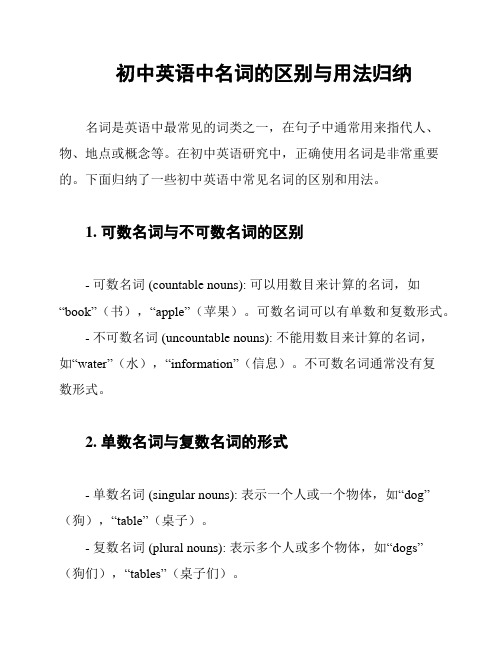
初中英语中名词的区别与用法归纳名词是英语中最常见的词类之一,在句子中通常用来指代人、物、地点或概念等。
在初中英语研究中,正确使用名词是非常重要的。
下面归纳了一些初中英语中常见名词的区别和用法。
1. 可数名词与不可数名词的区别- 可数名词 (countable nouns): 可以用数目来计算的名词,如“book”(书),“apple”(苹果)。
可数名词可以有单数和复数形式。
- 不可数名词 (uncountable nouns): 不能用数目来计算的名词,如“water”(水),“information”(信息)。
不可数名词通常没有复数形式。
2. 单数名词与复数名词的形式- 单数名词 (singular nouns): 表示一个人或一个物体,如“dog”(狗),“table”(桌子)。
- 复数名词 (plural nouns): 表示多个人或多个物体,如“dogs”(狗们),“tables”(桌子们)。
3. 名词所有格的用法名词所有格用来表示一个名词所属或拥有的关系。
常见的名词所有格的形式如下:- 单数名词 + 's:表示单数名词的所有关系,如“Tom's book”(汤姆的书)。
- 复数名词 + ':表示复数名词的所有关系,如“the students' bags”(学生们的书包)。
- 以-s 结尾的复数名词 + ':如“the girls' toys”(女孩们的玩具)。
4. 特殊名词的变化规则有一些名词的单数和复数形式变化规则比较特殊,主要包括以下几类:- 以-y 结尾的名词,将-y 变为-ies,如“baby”(宝贝)的复数形式是“babies”(宝贝们)。
- 以-f 或-fe 结尾的名词,将-f 或-fe 变为-ves,如“leaf”(叶子)的复数形式是“leaves”(叶子们)。
- 一些名词的单复数形式相同,如“sheep”(绵羊)和“fish”(鱼)。
名词用法总结归纳
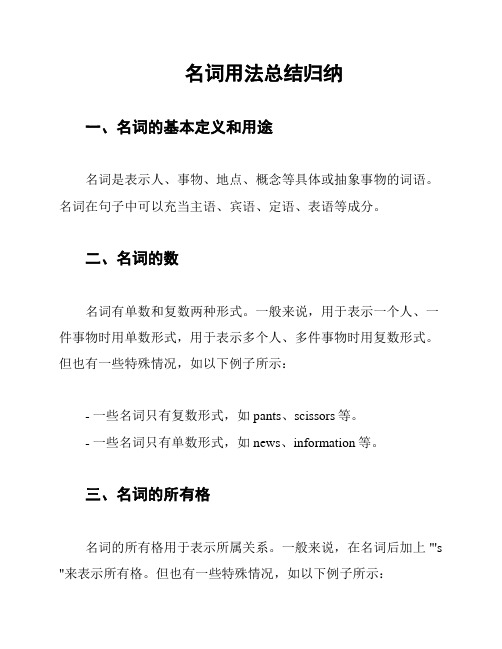
名词用法总结归纳一、名词的基本定义和用途名词是表示人、事物、地点、概念等具体或抽象事物的词语。
名词在句子中可以充当主语、宾语、定语、表语等成分。
二、名词的数名词有单数和复数两种形式。
一般来说,用于表示一个人、一件事物时用单数形式,用于表示多个人、多件事物时用复数形式。
但也有一些特殊情况,如以下例子所示:- 一些名词只有复数形式,如pants、scissors等。
- 一些名词只有单数形式,如news、information等。
三、名词的所有格名词的所有格用于表示所属关系。
一般来说,在名词后加上 "'s "来表示所有格。
但也有一些特殊情况,如以下例子所示:- 对于以 s 结尾的名词,只需在名词后加上 "'" 来表示所有格,如James' car。
- 对于以 s 结尾的复数名词,可以只在名词后加上 "'" 或在名词后加上 "'"s 来表示所有格,如the students' books 或 the students's books。
四、名词的性别有些名词是具有性别的,如man 和 woman。
在使用这类名词时要根据所要表达的性别选择正确的名称。
- 当要表示男性时,使用man。
- 当要表示女性时,使用woman。
五、名词的可数性名词根据其可数性可分为可数名词和不可数名词。
- 可数名词表示可以计数的事物,如book、chair等。
- 不可数名词表示无法计数的事物,如water、money等。
六、名词的分类名词还可以按照其表示的事物所属的类别进行分类。
- 人名:如John、Mary等。
- 地名:如London、Paris等。
- 物品名:如book、table等。
- 抽象名词:如love、happiness等。
以上是关于名词用法的总结归纳,希望对您有所帮助。
名词知识点的归纳总结
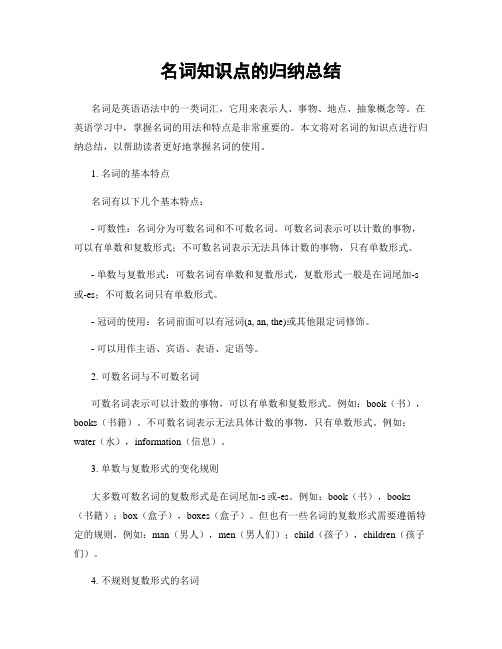
名词知识点的归纳总结名词是英语语法中的一类词汇,它用来表示人、事物、地点、抽象概念等。
在英语学习中,掌握名词的用法和特点是非常重要的。
本文将对名词的知识点进行归纳总结,以帮助读者更好地掌握名词的使用。
1. 名词的基本特点名词有以下几个基本特点:- 可数性:名词分为可数名词和不可数名词。
可数名词表示可以计数的事物,可以有单数和复数形式;不可数名词表示无法具体计数的事物,只有单数形式。
- 单数与复数形式:可数名词有单数和复数形式,复数形式一般是在词尾加-s 或-es;不可数名词只有单数形式。
- 冠词的使用:名词前面可以有冠词(a, an, the)或其他限定词修饰。
- 可以用作主语、宾语、表语、定语等。
2. 可数名词与不可数名词可数名词表示可以计数的事物,可以有单数和复数形式。
例如:book(书),books(书籍)。
不可数名词表示无法具体计数的事物,只有单数形式。
例如:water(水),information(信息)。
3. 单数与复数形式的变化规则大多数可数名词的复数形式是在词尾加-s或-es。
例如:book(书),books (书籍);box(盒子),boxes(盒子)。
但也有一些名词的复数形式需要遵循特定的规则,例如:man(男人),men(男人们);child(孩子),children(孩子们)。
4. 不规则复数形式的名词有一些名词的复数形式不遵循一般的规则,需要特殊记忆。
例如:woman(女人),women(女人们);mouse(老鼠),mice(老鼠们);tooth(牙齿),teeth(牙齿)。
5. 名词的所有格名词的所有格用来表示所属关系或所有关系。
通常在名词的后面加-apostrophe (')和-s。
例如:John's book(约翰的书);the girl's hat(女孩的帽子)。
6. 名词的分类名词可以根据其所表示的事物的性质或特点进行分类。
常见的名词分类包括:- 人名词:表示人的名字,如John(约翰)。
名词与代词的用法归纳与实例分析

名词与代词的用法归纳与实例分析名词和代词是语法中非常重要的词类,它们在英语句子中起着不可或缺的作用。
正确使用名词和代词可以使句子更加准确、清晰,表达更加流畅。
本文将针对名词和代词的用法进行归纳与实例分析,帮助读者更好地掌握它们的用法。
一、名词的用法归纳名词作为句子成分,主要包括名词的基本用法、名词的数与格以及名词的修饰等几个方面。
下面我们将逐一进行介绍。
1. 名词的基本用法名词可以用来表示人、事物、地点、抽象概念等。
它可以作为主语、宾语、定语、表语以及状语等成分出现在句子中。
例句1:The cat is sleeping on the sofa.(名词作为主语)例句2:Please pass me the book.(名词作为宾语)例句3:I bought a new car.(名词作为定语)例句4:She is a doctor.(名词作为表语)例句5:He ran out of the house.(名词作为状语)2. 名词的数与格名词有单数和复数两种形式,根据句子的结构需要选择合适的形式。
同时,名词还有所有格的用法,表示所属关系。
例句6:There is a pen on the table.(单数名词)例句7:There are two cats in the garden.(复数名词)例句8:This is my sister's book.(所有格名词)3. 名词的修饰名词可以被形容词、代词和连词等修饰,形容词和代词通常位于名词的前面,而连词则位于名词的后面。
例句9:She has a beautiful dress.(名词被形容词修饰)例句10:Give me your pen.(名词被代词修饰)例句11:He is a teacher and a writer.(名词被连词修饰)二、代词的用法归纳代词可以替代名词在句子中扮演名词的角色,起到简化句子、避免重复的作用。
下面我们将介绍代词的主要用法。
语法归纳总结常见的名词与代词用法

语法归纳总结常见的名词与代词用法名词与代词是英语语法中非常重要的部分,它们在句子中起着不同的作用。
本文将对常见的名词与代词的用法进行归纳总结,帮助读者更好地理解和应用。
一、名词的基本用法名词是表示人、事物、地点、想法等具体或抽象概念的词语。
名词的基本用法如下:1. 单数与复数名词可以表示单数或复数形式,单数表示一个人或物,复数表示两个或两个以上的人或物。
名词的复数形式通常在词尾加上字母"s",但也有一些特殊的复数形式,如"child"变成"children"。
2. 可数与不可数名词可数名词可以用来计数,可以有单数形式和复数形式,如"book"(单数)和"books"(复数)。
不可数名词表示抽象概念或无法具体计数的名词,它们没有复数形式,如"water"和"information"。
3. 名词的所有格所有格用于表示所属关系或归属关系。
常见的名词所有格形式为在名词后面加上"的",如"Tom的书"。
当名词以"s"结尾时,只需在名词后加上"'",如"James' book"。
但当名词以"s"结尾且不是复数时,需要在名词后加上"的",如"Paris的塔"。
二、代词的基本用法代词是用来替代名词或名词短语的词语,它们可以起到简化句子结构,避免重复使用名词的作用。
代词的基本用法如下:1. 主格与宾格代词根据其在句子中的作用可以分为主格和宾格。
主格代词用于作为主语,宾格代词用于作为宾语,如"I"(主格)和"me"(宾格)。
2. 形容词性与名词性代词还可以分为形容词性和名词性代词。
名词归纳知识点归纳总结
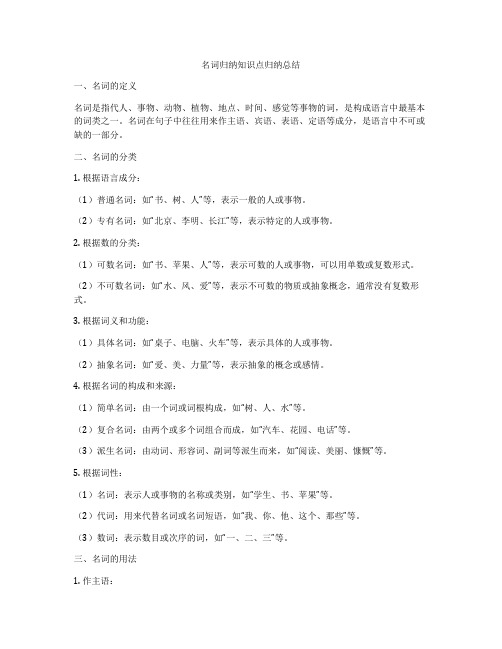
名词归纳知识点归纳总结一、名词的定义名词是指代人、事物、动物、植物、地点、时间、感觉等事物的词,是构成语言中最基本的词类之一。
名词在句子中往往用来作主语、宾语、表语、定语等成分,是语言中不可或缺的一部分。
二、名词的分类1. 根据语言成分:(1)普通名词:如“书、树、人”等,表示一般的人或事物。
(2)专有名词:如“北京、李明、长江”等,表示特定的人或事物。
2. 根据数的分类:(1)可数名词:如“书、苹果、人”等,表示可数的人或事物,可以用单数或复数形式。
(2)不可数名词:如“水、风、爱”等,表示不可数的物质或抽象概念,通常没有复数形式。
3. 根据词义和功能:(1)具体名词:如“桌子、电脑、火车”等,表示具体的人或事物。
(2)抽象名词:如“爱、美、力量”等,表示抽象的概念或感情。
4. 根据名词的构成和来源:(1)简单名词:由一个词或词根构成,如“树、人、水”等。
(2)复合名词:由两个或多个词组合而成,如“汽车、花园、电话”等。
(3)派生名词:由动词、形容词、副词等派生而来,如“阅读、美丽、慷慨”等。
5. 根据词性:(1)名词:表示人或事物的名称或类别,如“学生、书、苹果”等。
(2)代词:用来代替名词或名词短语,如“我、你、他、这个、那些”等。
(3)数词:表示数目或次序的词,如“一、二、三”等。
三、名词的用法1. 作主语:例句:书籍是知识的源泉。
解析:主语“书籍”是一个名词,表示主动或被动的人或事物。
2. 作宾语:例句:我买了一本新书。
解析:宾语“书”是一个名词,表示动作的承受者或受益者。
3. 作定语:例句:学生宿舍的窗户很干净。
解析:定语“学生”是一个名词,修饰名词“宿舍”。
4. 作表语:例句:那里是我们的家。
解析:表语“家”是一个名词,表示主语的属性或状态。
5. 作状语:例句:我每天都去学校。
解析:状语“每天”是一个名词,修饰动词“去”。
四、名词的派生和构词法1. 名词的派生:名词可以通过加前缀、后缀、构词等方式派生出新词。
语法归纳名词的分类与用法

语法归纳名词的分类与用法名词是英语语法中的一类词汇,用来指代人、物、地点、抽象概念等。
在句子中,名词通常作为主语、宾语、表语或定语等。
本文将对名词的分类与用法进行归纳,并提供相关例句加以说明。
一、名词的分类1.可数名词(countable nouns):指可以用数目进行计数的名词,包括单数和复数形式。
复数名词通常在词尾加-s或-es。
例:dog(狗)- dogs(狗们)cat(猫)- cats(猫们)2.不可数名词(uncountable nouns):指无法用数目进行计数的名词,通常表示抽象概念、质量、物质等。
不可数名词没有复数形式,不能与"a" 或 "an" 这样的不定冠词连用。
例:water(水)information(信息)3.可数名词与不可数名词的转化:有些名词可以既作可数名词又作不可数名词,但意义略有不同。
例:a tea(一杯茶)tea(茶叶)二、名词的用法1.名词作主语:名词可以作为句子的主语,引导句子的主题。
例:Books are my best friends.(书是我最好的朋友。
)2.名词作宾语:名词可以作为句子的宾语,说明动作的承受者。
例:I love music.(我喜爱音乐。
)3.名词作表语:名词可以作为句子的表语,说明主语的身份、状态或特征。
例:He is a doctor.(他是一名医生。
)4.名词作定语:名词可以作为另一个名词的修饰语,起到限定或说明作用。
例:a bookshelf(一个书架)5.名词所有格:名词可以通过添加"’s" (单数所有格)或"’"(复数所有格)表示所属关系。
例:my brother's car(我弟弟的车)the students' books(学生们的书籍)6.名词在句子中的位置:名词在句中通常出现在动词、介词或形容词后。
例:I have a cat.(我有一只猫。
名词的用法归纳总结
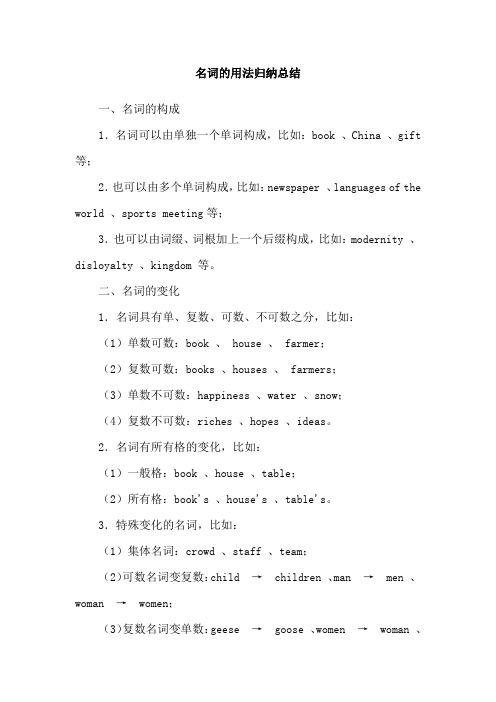
名词的用法归纳总结一、名词的构成1.名词可以由单独一个单词构成,比如:book 、China 、gift 等;2.也可以由多个单词构成,比如:newspaper 、languages of the world 、sports meeting等;3.也可以由词缀、词根加上一个后缀构成,比如:modernity 、disloyalty 、kingdom 等。
二、名词的变化1.名词具有单、复数、可数、不可数之分,比如:(1)单数可数:book 、 house 、 farmer;(2)复数可数:books 、houses 、 farmers;(3)单数不可数:happiness 、water 、snow;(4)复数不可数:riches 、hopes 、ideas。
2.名词有所有格的变化,比如:(1)一般格:book 、house 、table;(2)所有格:book's 、house's 、table's。
3.特殊变化的名词,比如:(1)集体名词:crowd 、staff 、team;(2)可数名词变复数:child → children 、man → men 、woman → women;(3)复数名词变单数:geese → goose 、women → woman 、children → child;(4)复合名词:sister-in-law 、court-martial 、passer-by 。
三、名词的使用1.在句中作主语,比如:The Internet is a great invention.(Internet 是一个伟大的发明。
)2.在句中作宾语,比如:I read a book last night.(我昨晚读了一本书。
)3.在句中作定语,比如:Tom is a student of our school.(汤姆是我们学校的一名学生。
)4.在句中作表语,比如:The music is beautiful.(这首音乐很美。
- 1、下载文档前请自行甄别文档内容的完整性,平台不提供额外的编辑、内容补充、找答案等附加服务。
- 2、"仅部分预览"的文档,不可在线预览部分如存在完整性等问题,可反馈申请退款(可完整预览的文档不适用该条件!)。
- 3、如文档侵犯您的权益,请联系客服反馈,我们会尽快为您处理(人工客服工作时间:9:00-18:30)。
名词用法归纳-标准化文件发布号:(9556-EUATWK-MWUB-WUNN-INNUL-DDQTY-KII名词用法归纳 March 16, 2008一.名词的分类:名词分为专有名词和普通名词。
专有名词: 人名, 地名, 机构等名称。
如:Tom,Shanghai , Beijing University 普通名词: 某类人或东西中的个体。
如:boy, dog, country集体名词: 若干个体组成的集合体。
如:family, team, police物质名词: 无法分为个体的实物。
如:air, water, food抽象名词: 动作, 状态, 感情等抽象概念。
如:progress, health, fun(注意:普通名词和集体名词可数。
物质名词和抽象名词不可数。
)二.名词的数:可数名词都有单数和复数之分。
1.规则的可数名词的复数变化规则1) 一般情况加 s 。
如:books, mouths, houses2) 以 s , sh , ch , x结尾的加 es。
如:classes , boxes, matches (但stomachs)3) 辅音字母 + y结尾的变 y为 ies。
如:cities, countries, parties4) 以 o 结尾的词多数 + es。
如:heroes, tomatoes, potatoes, zeroes / zeros以 o 结尾并且词尾有两个元音字母 +s。
如:radios, zoos, bamboos(但pianos , kilos,photos)5) 以f, fe 结尾的多数 + es。
如:leaves , lives ,wolvesThe thief’s wife killed three wolves with some leaves and knives in ha lf of her life.但:也有一些 + s。
如:roofs , proofs, gulfs, beliefs(handkerchiefs / handkerchieves)6)特殊变化的名词。
foot--- feet tooth--- teeth2goose---geese ox---oxenchild--- children mouse---miceman / woman--- men / women2. 名词词尾的读音规则1)在[ p] [t] [k] [f]等清辅音后读[s]。
如:cups, cakes,roofs2) 在[s] [z] [∫] [t∫]等音后读[iz]。
如:glasses, faces, roses3) 在其他情况下读作[z]。
如:beds, days, knives4) 以th结尾的词原来读清辅音,加词尾后多数读浊辅音。
如: mouth—mouths, path—paths但也有不变化的,如: month—months, ninth—ninths, youth—youths(但houses)3. 不规则的可数名词的变化规则1) man—men, woman—women, tooth—teeth, foot—feet, child—children,mouse—mice, goose---geese, ox---oxen2) 单复数相同: sheep, fish, deer, means, Chinese, Japanese, works,fish等。
如表示不同种类的鱼时复数是fishes。
如:There are many kinds of fishes in that lake.3) 以man, woman 修饰名词构成合成词时, 两个词都变化。
man servant — men servants. (但boy / girl students)woman doctor — women doctors.4.复合名词的复数形式son-in-law — sons-in-law , looker-on — lookers-on 主体名词变化。
film-goer — film-goers, grown-up — grown-ups 没有主体名词,词尾加复数。
5.字母,阿拉伯数字的复数形式一般加’s 或 sThere are two l’s in the word “ all ”.Your 7’s and 9’s look alike.3It happened in the 1960’s /1960s.I will not accept your if’s and but’s.6. 物质名词一般没有复数,有时用复数形式表示不同种类。
wheats, foods, fruits, vegetables有时表示比原文更广的词义:wood—woods, water—waters, sand—sands, manner—manners7. 抽象名词一般不可数;但是如果表示某一具体的情况,或各种各样的也有可数名词的用法。
He jumped with joy.My children are a great joy to me.8. 定冠词加姓氏的复数表示一家人。
the Turners, the Smiths, the Wangs9. 集体名词people, police, cattle 总是作复数。
( people 作民族、种族时, 有单复数两种形式)Many cattle are kept on the farm.Several police were on duty.The Chinese are a brave and hard-working people.The English are a funny people.10. 集体名词class, public, family, population, team, crew, committee 等单复数都有,但意义不同。
The class is big.The class are taking notes in English.(前者看作整体,后者强调每一个人。
)The population in China is larger.80% of the population in China are peasants. (同上)11. hair, fruit 通常作单数,表示总体。
His hair is grey.4They have a rich harvest of fruit almost every year.如果表示若干根头发,表示种类的水果时,可以加复数词尾。
He had a few white hairs. 他有几根白发。
Are fruits on sale in this season这个季节有水果销售吗?12. 以s 结尾的学科名词只作单数。
mathematics , physics, politics, 等。
13. glasses, trousers, scissors, shoes, spectacles,等常用复数;但如果这些词前用a pair of …/ this pair of…/ that pair of…等修饰时谓语动词由pair 来决定。
Where are my glassesMy new pair of trousers is too long.Here are some new pairs of shoes.14. 不可数名词没有复数形式,常考的不可数名词有:progress, advice, fun, practice, news, information, knowledge, weather,equipment, furniture, clothing, jewellery, luggage, baggage, food, bread,nature, space…如果表示“一个”的概念,可用单位词。
a piece of news / information / advice / bread / cake / paper / meat / coal /equipment / furniturea bottle of ink, a grain of rice , a cake of soap抽象名词具体化可加不定冠词,如:a pleasure, a surprise, a help, a success,a failure, a shock, a pity, a shame, a joy, a sorrow, a difficulty, a trouble15. 名词作定语1)表示用途:a coffee cup 咖啡杯a tobacco company 烟草公司5a vegetable garden2)表示材料:a stone bridge 石桥paper money 纸币a diamond necklace 钻石项链3)表示时间或地点:winter holiday 寒假morning paper 晨报city people 市民4) 表示类别:a shoe shop, street lights, seat belts, a telephone number, waterpollution 水污染,body temperature 体温,weight problem 体温5)表示身份:a woman doctor,a boy student注意:名词作定语常用单数: shoe shop,college students,basketball match但man / woman 随后边名词变化: a woman doctor,two women doctorsa man doctor,two men doctors6) 有些只用复数做定语a sports meeting, a goods traina sales manager, a customs officer三. 名词的所有格:1.有生命的名词所有格的构成1)一般在词尾加’s: the tea cher’s office,today’s newspaper2)以 s 结尾的复数名词只加’:workers’ rest homes工人疗养所the masses’ request群众的请求3) 不以s结尾的复数名词加’s:children’s toys4) 复合名词只在最后一个词的后面加’s: my sister-in-law’s brother65) 表示共同所有的几个名词,只在最后一个词的后面加’s:This is Tom, Bob and Dick’s room.6) 表示各个所有关系的几个名词,在每个名词后分别加’sat Mr. Green’s , at my uncle’s, at the tailor’sJenny’s, Jean’s and Mary’s rooms face to the south.7) 名词短语只在最后一个词后加’sa quarter of an hour’s talk, a ten minutes’ drive, a four days’ holiday2. 名词所有格的用法:1) 名词所有格主要用于表示有生命的名词,表示所属关系。
